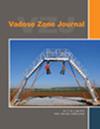利用物理信息神经网络和非饱和水流模型对层状土壤剖面的土壤水力参数进行反分析
IF 2.8
3区 地球科学
Q3 ENVIRONMENTAL SCIENCES
引用次数: 0
摘要
要利用基于过程的模型准确预测田间尺度的土壤水流以及化学物质和热量的耦合运动,就必须了解土壤水力参数的空间分布情况。物理信息神经网络(PINNs)可以在深度学习中提供物理约束,从而获得无网格解,可用于从较少且噪声较大的训练数据中反向估算土壤水力参数。以往使用 PINNs 的研究已成功估算出均质土壤的土壤水力参数,但在界面深度和参数未知的情况下,估算层状土壤剖面的此类参数仍存在一些困难。本研究的目的是开发 PINNs,通过在给定深度的渗透过程中根据模拟结果从训练数据中预测压力水头的变化,直接反向估算层状土壤剖面中土壤水力参数的分布,如饱和导水性、Mualem-van Genuchten 模型的 α 和 n。研究了影响 PINN 性能的各种因素的影响,如分配给损失函数各组成部分的权重、误差计算中使用的时间范围以及用于评估物理约束的样本数量。通过加大物理约束的权重,并在损失函数中排除早期渗透阶段,成功估算出了层状土壤中压力水头的变化和三个土壤水力参数的分布。所开发的 PINN 可进一步应用于更复杂的土壤,并可加以改进。本文章由计算机程序翻译,如有差异,请以英文原文为准。
Inverse analysis of soil hydraulic parameters of layered soil profiles using physics‐informed neural networks with unsaturated water flow models
Information about the spatial distribution of soil hydraulic parameters is necessary for the accurate prediction of soil water flow and the coupled movement of chemicals and heat at the field scale using a process‐based model. Physics‐informed neural networks (PINNs), which can provide physical constraints in deep learning to obtain a mesh‐free solution, can be used to inversely estimate soil hydraulic parameters from less and noisy training data. Previous studies using PINNs have successfully estimated soil hydraulic parameters for homogeneous soil but estimating such parameters of layered soil profiles where the interface depth and the parameters are unknown still has some difficulties. The objective of this study was to develop PINNs to inversely estimate the distribution of soil hydraulic parameters, such as saturated hydraulic conductivity and α and n of the Mualem–van Genuchten model directly within layered soil profiles by predicting changes in the pressure head from training data based on simulation results at given depths during infiltration. The impact of factors affecting PINNs performance, such as the weights assigned to each component of the loss function, time range used in error computations, and number of samples used to assess the physical constraint, was investigated. By assigning a larger weight to the physical constraint and excluding the earlier stage of infiltration in the loss function, the changes in the pressure head and the three soil hydraulic parameter distributions within the layered soil were successfully estimated. The developed PINNs can be further applied to more complex soils and can be improved.
求助全文
通过发布文献求助,成功后即可免费获取论文全文。
去求助
来源期刊

Vadose Zone Journal
环境科学-环境科学
CiteScore
5.60
自引率
7.10%
发文量
61
审稿时长
3.8 months
期刊介绍:
Vadose Zone Journal is a unique publication outlet for interdisciplinary research and assessment of the vadose zone, the portion of the Critical Zone that comprises the Earth’s critical living surface down to groundwater. It is a peer-reviewed, international journal publishing reviews, original research, and special sections across a wide range of disciplines. Vadose Zone Journal reports fundamental and applied research from disciplinary and multidisciplinary investigations, including assessment and policy analyses, of the mostly unsaturated zone between the soil surface and the groundwater table. The goal is to disseminate information to facilitate science-based decision-making and sustainable management of the vadose zone. Examples of topic areas suitable for VZJ are variably saturated fluid flow, heat and solute transport in granular and fractured media, flow processes in the capillary fringe at or near the water table, water table management, regional and global climate change impacts on the vadose zone, carbon sequestration, design and performance of waste disposal facilities, long-term stewardship of contaminated sites in the vadose zone, biogeochemical transformation processes, microbial processes in shallow and deep formations, bioremediation, and the fate and transport of radionuclides, inorganic and organic chemicals, colloids, viruses, and microorganisms. Articles in VZJ also address yet-to-be-resolved issues, such as how to quantify heterogeneity of subsurface processes and properties, and how to couple physical, chemical, and biological processes across a range of spatial scales from the molecular to the global.
 求助内容:
求助内容: 应助结果提醒方式:
应助结果提醒方式:


